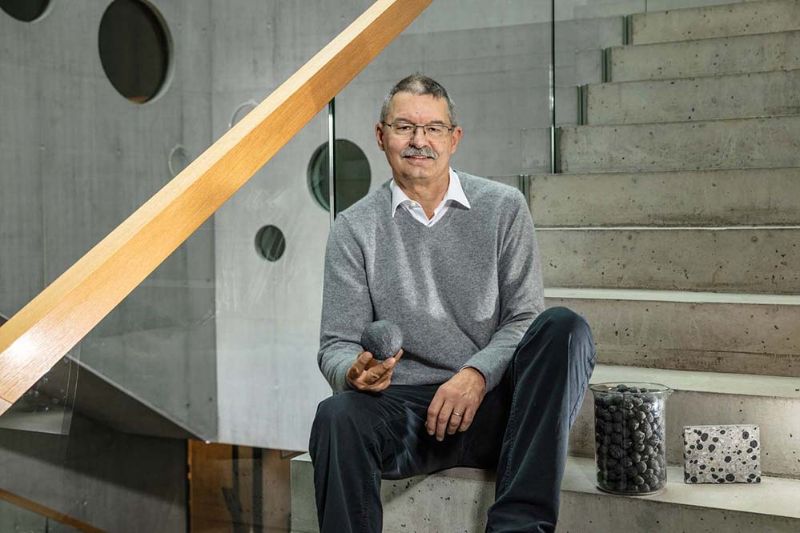"From scapegoat to saviour"
Mr Richner, you want to use the atmosphere as a source of CO2, a process you call “mining the atmosphere”. How would this actually work?
The thing we have to make clear first of all is that, as hard as reaching our target of net zero by 2050 is, it is only one step on our journey. After 2050, we have to achieve negative emissions to an extremely high degree, otherwise our efforts will be for nothing.
Negative? Is reducing CO2 emissions beyond zero even possible?
Yes, it is possible. The way to do this is by recovering a significant proportion of the emitted CO2 from the atmosphere.
What is the difference between your approach and that of carbon capture and storage (CSS), which has proven so controversial?
It goes without saying that I am obviously in favour of anything that would minimise CO2 emissions. The problem with CCS in my view, however, is that it does not create any value. The process of storing CO2 from the atmosphere in the ground only generates costs. Our approach starts from a similar place, but we aim to find a way to use the captured carbon. You could call it CCU: carbon capture and use.
Use? How exactly could you use all that carbon?
That is the big question. Who would have a use for such massive amounts of carbon? Not as fuel, but as a material. The first answer that springs to mind is the construction sector. We are not talking about a few thousand tons here, but hundreds of millions.
And the carbon could be used here? Could we build houses out of carbon?
Not quite, but something along those lines. We have developed a type of light-weight concrete that is mixed with carbon pellets. It’s not high-performance concrete, but it is sufficient for most uses. This provides a sink in which the CO2 is permanently retained.
But doesn’t producing concrete also generate lots of CO2?
We can actually achieve carbon-neutral concrete production with the materials available today, but we believe that we will be able to generate minus 100 kg CO2 /m3 or even less in future. And all of a sudden, that means the more concrete we produce, the better it is for the environment. This opens up whole new opportunities, particularly when you look at the development of the construction sector from a global perspective. Just think of all the construction and infrastructure projects in China, or all of the countries that have virtually no infrastructure at all.
But where will this carbon be produced? And where will the energy come from?
That is the second big issue. We won’t make it here, but rather wherever there is a lot of energy available. The assumption I am about to make may be slightly controversial, but I believe that we will one day reach the point where we have plentiful renewable energy. Oil-producing nations know that the days of making easy money from fossil fuels are numbered, but they still want to be big players in energy supply in the future. That is why they are investing massively in solar power.
Hang on, that sounds strange. You want to use solar energy to make carbon?
Not directly. We can use electricity to create hydrogen, which we then use to turn CO2 into methane. We then transport this methane as a liquefied gas to where it is needed. This will allow us to import renewable energy to Switzerland. There will definitely be demand for this, especially in winter. The important thing is how you turn the methane into carbon. This process is called pyrolysis and it releases hydrogen while generating carbon as a byproduct. Since carbon has the highest carbon dioxide density of any material, this is extremely practical.
Is concrete the only suitable reservoir for this carbon?
We are currently looking into other possibilities. Asphalt could be highly suitable, for example, as could insulation material. There is plenty of room for development.
There have been other suggestions of how to make the construction sector a sink for CO2. The German climate expert Hans Joachim Schellnhuber is championing wood, for example. Is that not more efficient?
Using wood in construction certainly makes a lot of sense in areas where it is plentiful. However, once the wood has reached the end of its useful life, you can’t just burn it, otherwise you generate more CO2. We have to remove carbon from the cycle for several centuries, not just 50 years.
Speaking of time, houses don’t last forever either. What happens in the event of demolition?
We have to rethink things here as well. We need a “design for disassembly”. This means that the carbon stays in circulation for a few cycles and the components can be reused in new buildings. Afterwards, they would then be placed in a mineral landfill, which would create a final sink.
This all sounds good in theory, but politics always plays a role. How can we get this technology off the ground in a big way?
We will need a gradual approach – this could mean pyrolysing organic material into carbon at first. What is clear is that CO2 emissions must have a price, and those doing the emitting must pay. But in turn, this means those who build can get money back. It’s all about creating the right incentives. We absolutely have to create solutions that can be accepted by a majority of the population.
Now you really sound like a politician. Do you see this research work as a kind of social engagement?
Absolutely. I understand the challenges, but we want to highlight the solutions that can really work instead of just saying, “Oh no, all is lost.” We have been pumping out emissions for free for around 200 years, which has created an enormous debt burden for our civilisation. Our job now is to put this right.
